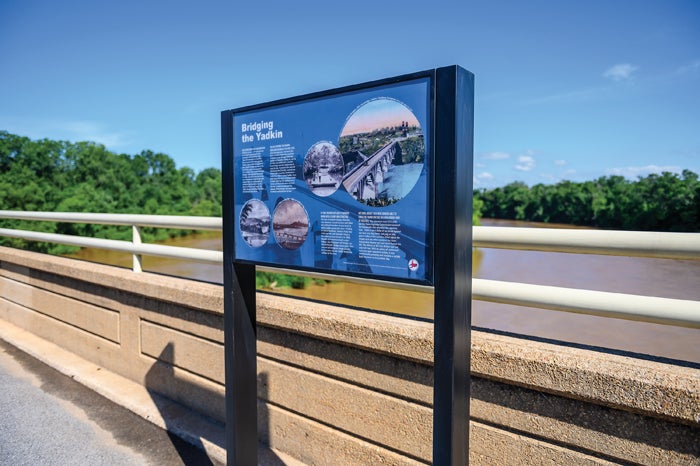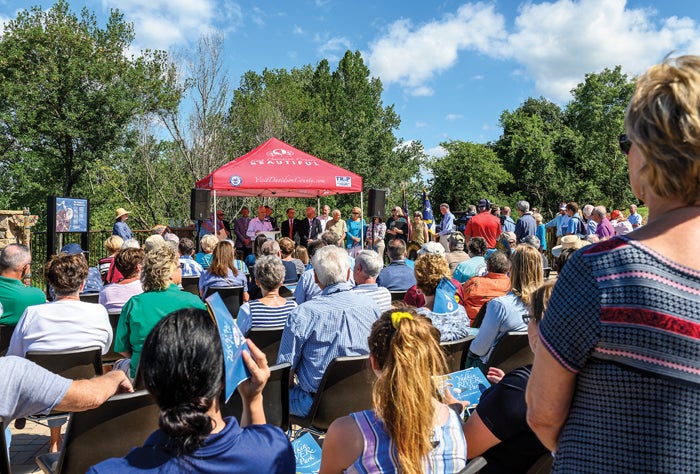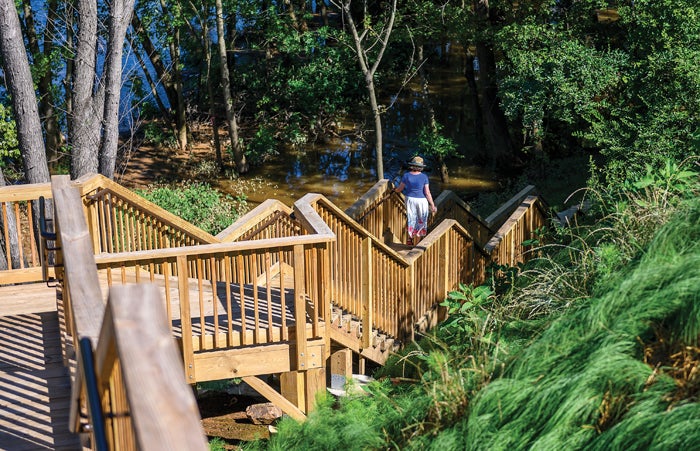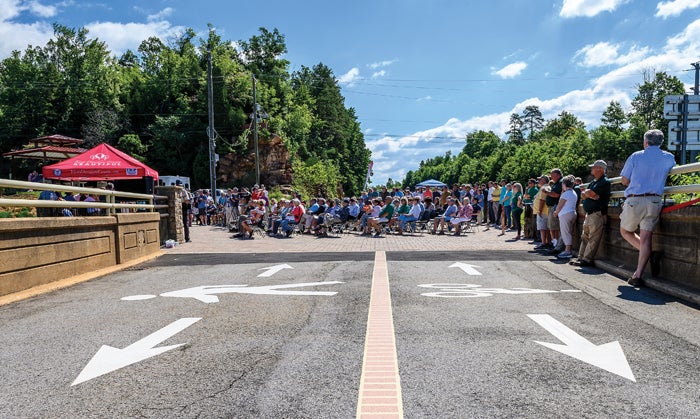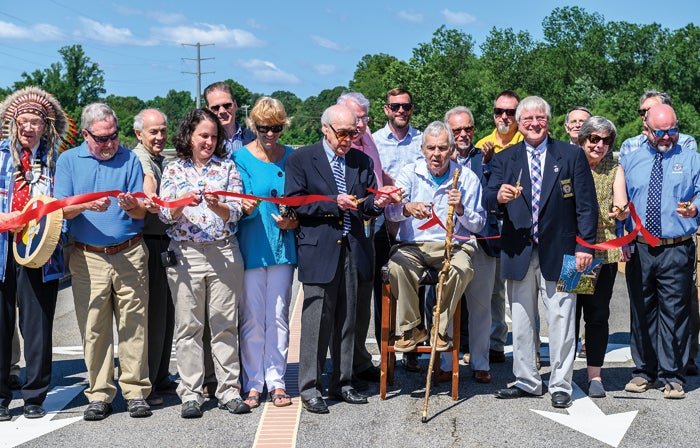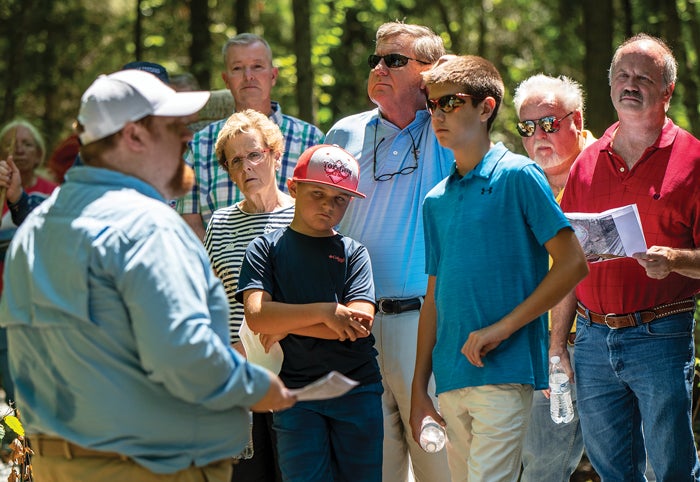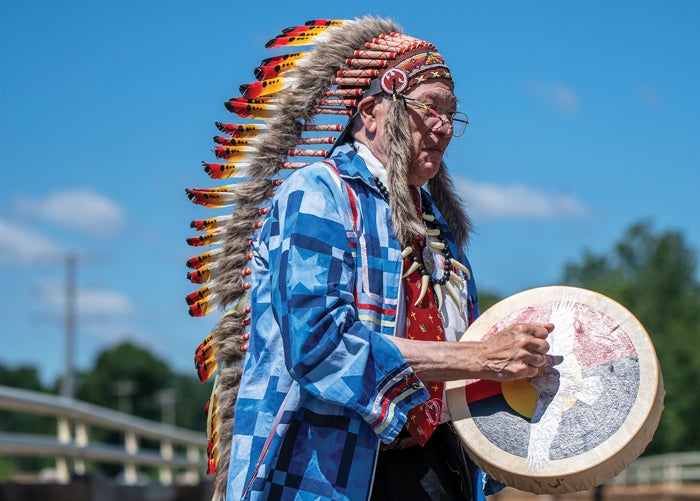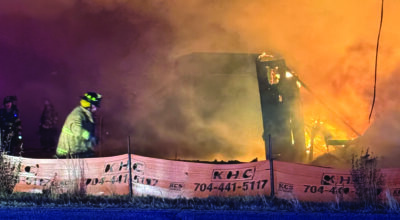Large crowd attends ribbon-cutting for Yadkin River Park
Published 12:00 am Saturday, June 22, 2019
By Mark Wineka
mark.wineka@salisburypost.com
DAVIDSON COUNTY — If you haven’t been to the Wil-Cox Bridge lately, you’re in for a surprise.
The 1,300-foot bridge is equally divided with a bicycle lane and a pedestrian lane, complete with a couple of covered benches facing the Yadkin River.
Max Walser said someone called him the other night to let him know the bridge was getting a lot of use — so much so that dogs were leaving their calling cards.
“We’re working on that part of it, too,” Walser told a crowd Friday morning gathered for the ribbon-cutting of Yadkin River Park.
The 1924 Wil-Cox Bridge is one of stars in the first phase of this new Davidson County park, which also encompasses the York Hill boat access and Fort York historic site.
For now, Yadkin River Park offers the Wil-Cox pedestrian and bike bridge, 1.3 miles of hiking and biking trails, a plaza entrance, two picnic shelters, shade structures on the bridge with benches, a rain garden, information kiosks, parking, and a staircase and riverwalk connecting the Wil-Cox Bridge to the York Hill boat access.
All of this is on the Davidson County side of the Yadkin, with access from U.S. 29.
Nothing on the Rowan County side, which used to be dominated by the N.C. Finishing Co. plant, has yet changed.
Walser, chairman of the Yadkin River Park Planning Committee, said it speaks highly of the project that so many “heavy hitters from Raleigh” attended the ribbon-cutting.
Romana Bartos, director for the Division of Historical Resources for the N.C. Department of Cultural Resources, praised the “courageous leadership” of Davidson County for taking ownership of the Wil-Cox Bridge in 2010 from the N.C. Department of Transportation.
Then it was Davidson County government entities, the Yadkin River Park Planning Committee, and a vast number of partnerships and funding from federal, state and local agencies and foundations that combined to make the park a reality.
Bartos said the new park is a textbook example of ecotourism and heritage tourism blending with recreational opportunities. It immediately creates a respite for travelers on Interstate 85, which officials said can see upward of 100,000 vehicles a day.
Stephanie Blair, an aide to U.S. Sen. Thom Tillis, read remarks on the senator’s behalf. Tillis called the opening of the park an “exciting milestone” and “an asset for generations to come.”
“This is a success story of many levels of cooperation,” said Department of Transportation official Michael Fox, who also noted, “There’s a lot of history in this little part of the world.”
From a historical point of view, the new Yadkin River Park stands on hallowed ground.
Think of Native Americans living on these banks 12,000 years ago. Think of Spanish explorer Juan Pardo coming through in 1567.
Continental Army Maj. Gen. Nathanael Greene crossed the river in this area, and thanks to rising waters overnight, he eluded a pursuing British company headed by Lt. Gen. Charles Cornwallis.
Historians consider it a turning point in the Revolutionary War.
From the Fort York bluff overlooking the Yadkin River on April 12, 1865, Confederates successfully defended the railroad bridge against Union soldiers who earlier in the day had overrun Salisbury. It was one of the last fights of the Civil War, and in less than a month Fort York was abandoned.
In the modern era, this area — and its bridges — have been vital to transportation, notably the cars and trucks on I-85 and U.S. 29 and northbound and southbound freight and passenger trains.
Hanna Cockburn, director of the Bicycle and Pedestrian Division of the N.C. Department of Transportation, said she remembers sitting at a conference table 15 years ago and first talking about the Wil-Cox Bridge, which was slated to be abandoned, and what it could be.
She and others, including DOT Division 9 Engineer Pat Ivey, expressed gratitude and satisfaction for being part of a long-term project that was completed.
“We may have had this project come to fruition without Pat, but I doubt it,” Walser said.
Ivey said he never tries to miss an opportunity to talk about the DOT and partnerships — and this was one of them.
“I want to give Davidson County credit for being as persistent as they were,” he said.
Cockburn said Davidson County took a “leap of faith” in taking ownership of the Wil-Cox Bridge, but now it will serve as the important connection between the Carolina Thread Trail and Piedmont Legacy Trail.
N.C. Rep. Steve Jarvis, R-Davidson, said Walser and Sim DeLapp, another important planning committee member, don’t get the credit they deserve in making the Yadkin River Park happen.
“I have to be honest with you,” Jarvis said. “I had a little bit of doubt.”
Jarvis said he hopes there is $95,000 in the final state budget that will go toward the Fort York portion and $50,000 that will purchase additional land for the park overall.
“We have dreamers in our midst,” Jarvis said. “No dream is too big, no challenge is too great. This is something the state of North Carolina is proud of.”
N.C. Sen. Eddie Gallimore, R-Davidson, also gave credit to the work of N.C. Rep. Larry Potts, R-Davidson, in securing funding for Yadkin River Park.
Gallimore said he grew up in the country and as a boy never thought about parks with all the places to play around him. But now that he’s a city dweller at least three days a week, Gallimore said, he sees the importance of projects like this across the state.
Walser used much of his time Friday morning naming and recognizing every individual involved with the park. Foremost were members of the Yadkin River Park Planning Committee.
Besides himself and DeLapp, members included Lance Barrett, Nelda Bennett, Kathryn Clifton, Guy Cornman, Lee Crook, Zak Crotts, Spencer Mayor Jim Gobbel, Gary Hall, Thomas Mashburn, Betty Pfeiler, Chris Phelps, Bill Phillips, former Salisbury City Planner Lynn Raker, Steve Shell, Jason Walser, Chris Watford, Karen Watford, Nick Bishop, Edgar Miller and Salisbury’s Ronnie Smith.
After the ribbon-cutting, Chris Watford served as a history expert and tour guide for a large group that walked the newly constructed trails on the Fort York site and saw where its infantry trenches and artillery batteries had been.
Yadkin River Park serves as the northernmost access to High Rock Lake. It’s also the end of the 22-mile Daniel Boone Heritage Canoe Trail.
Future trail connections could be 3.5 miles to the N.C. Transportation Museum, a proposed greenway of five to seven miles to the I-85 Corporate Center and an 11-mile trail to Boone’s Cave Park.
Contact Mark Wineka at 704-797-4263.


